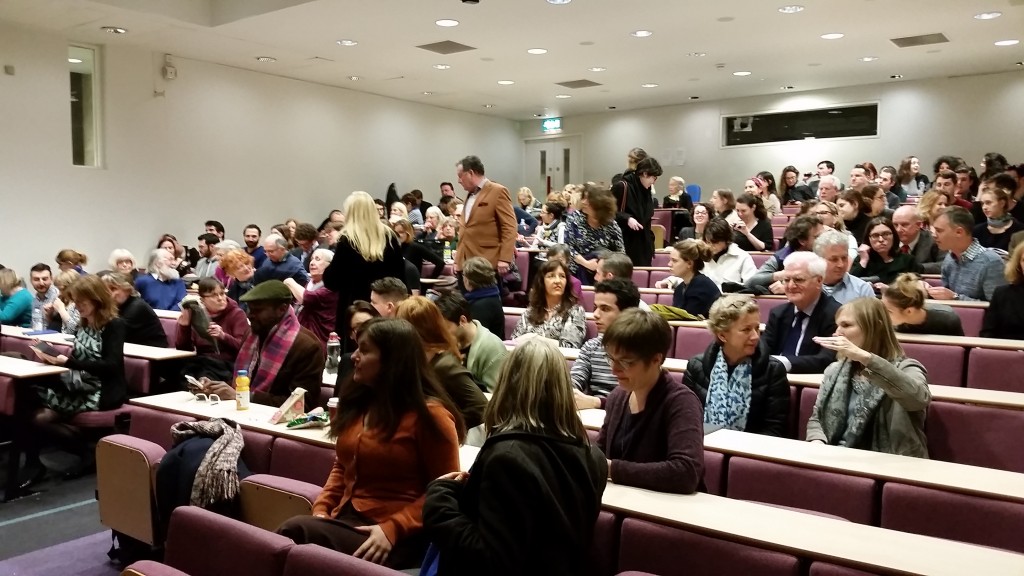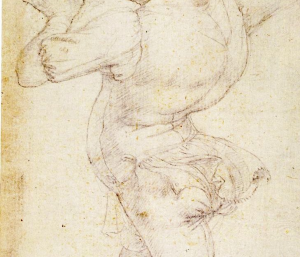We have reached the start of the Easter vacation, and the Spring term came to a splendid close last week with the Murray Lecture 2016! Professor Patricia Rubin, Judy and Michael Steinhardt Director at the Institute of Fine Arts, New York University, delivered a wonderful talk entitled ‘Bent Elbows, Bare Bottoms, and Bending Meanings: Shifting Perspectives on Viewing the Male Body in Art’, to a packed Clore Lecture Theatre.
Professor Rubin’s focus was Donatello’s David, but her deep and insightful analysis took us all the way from Dante through to 1970s Soho! It was great to see so many familiar faces in the audience: members of staff; retired colleagues, such as Professor Francis Ames-Lewis; the Trustees of the Murray Bequest who generously support this biennial event; interested academics from across London and beyond; and a very wide range of students, past and present. As well as lots of current students from our Certificate, BA, MA and MPhil/PhD programmes, I spotted many who have graduated from those courses in recent years amongst the audience. The best represented cohort in the room, however, was definitely those taking Dr. Monica Bohm-Duchen’s level 6 module, ‘Art and Scandal in the Modern Period’. They’d been scheduled to have a class at the same time as the Murray lecture, but had agreed to move it to 7.30pm, so they could all come and see Professor Rubin’s talk! Here’s an image of the poster I secreted in my bag at the end of the evening, to brighten up my office wall.
 I’ve been having a number of meetings recently with some colleagues from Careers and Employability, not least as we’re planning an event for History of Art students for late June, which will cover key skills, such as CV writing, as well as potential career paths for those graduating from our programmes. More anon! In the meantime, here are a few words from Alex Jones, Employability Consultant:
I’ve been having a number of meetings recently with some colleagues from Careers and Employability, not least as we’re planning an event for History of Art students for late June, which will cover key skills, such as CV writing, as well as potential career paths for those graduating from our programmes. More anon! In the meantime, here are a few words from Alex Jones, Employability Consultant:
‘Birkbeck Careers and Employability is a service created and designed specifically to support our students in the unique environment the University offers. We offer a wide range of activities to enhance your prospects both during and after your study.
We run a programme of workshops throughout the term, have a daily drop in service in Malet Street and provide access to a 24/7 careers portal accessible through your MyBirkbeck profile.
We’re also proud that we have excellent links into industry and frequently have employers here on campus. That could be for a one off event, an ‘employer in the foyer’ drop in visit or attending one of the two careers fairs we’re running across this year.
To find out more about our services, upcoming events or ways to engage with us then find us at www.bbk.ac.uk/careers or follow us on Twitter @BirkbeckCareers.’
On this subject, I also want to alert you to a very useful new page on the website, recently created by my colleague Dr. Fiona Candlin, on ‘Volunteer and interning opportunities in museums and galleries’. It provides some useful general information about volunteering and internships, and also details of some current opportunities.
I’m going to hand over the final part of this blog to Anna Jamieson, currently on our part-time MA History of Art programme, who’s written a wonderful account of the route that brought her to study in the department, and about her experiences in her time with us. But, before I do, I’d like to wish everyone a restful and productive Easter vacation – and send particular good wishes to those BA students engrossed in the final stages of their dissertations!
Anna Jamieson, current part-time MA History of Art student
‘My decision to study at Birkbeck happened rather quickly. In fact, it didn’t really feel like a conscious decision at all! I’d been thinking about continuing to postgraduate study ever since graduating in History/History of Art from Leeds in 2011. I was working full time for a London based art fair, and felt that, to return to study, a radical life change was in order. I would have to quit my job, which I loved, and find a cheaper place to live.
But when I saw the details of the part-time History of Art MA in the Birkbeck prospectus, I realised it was more manageable than I thought. I could pay the fee each month and coordinate the classes around my job (one lecture or seminar a week was far more feasible than I’d imagined). I put an application together, sent it through and found myself nervously meeting my fellow students in our first class, one late September evening.
What I’ve enjoyed about Birkbeck most is the broad scope of topics that the History of Art MA allows. For someone like me who sometimes finds it hard to find an academic focus, it’s proved ideal. I was able to study Holocaust memorials in Germany and Austria during our first term – a subject I’d studied during my BA – before developing some of these ideas in my summer Research Project, where I dipped my toes into archival research and met some amazing London-based curators and librarians. I took Suzannah Biernoff’s ‘Exhibiting the Body’ module, focusing on the unsettling anatomical models of ‘wax Venuses’: technically medical instruments, but with highly sexualised bodies, parted lips and gendered accessories. Last Autumn, I embarked on Tag Gronberg’s module on fin-de-Siecle Paris, and wrote my essay on the domestic interiors of the fascinating Edouard Vuillard and the balance between intimacy and spectacle within his paintings.
These topics may all seem quite detached, but throughout the course I’ve been able to find underlying themes and theorists that link them together. I’ve now started writing my dissertation on ‘Dark Tourism’ in eighteenth-century London.
At times, balancing the MA with my job has admittedly been a challenge. Having to decline an invitation because I just knew I had to be at the library was, at first, difficult, but, in time, my friends and family got used to the fact that I wasn’t as available as I’d been before. I ended up starting a new job in Development at a central London gallery, a twenty minute walk from Birkbeck which meant I could grab a book in my lunch break or pop in for an hour after work. After a few months, my employers allowed me to work four days a week in order to focus on the course, which helped enormously. I was amazed when they agreed to reduce my hours; it just proves that you never know how flexible your work might be unless you ask.
In December I decided to go freelance, in order to focus on both the Masters and freelance arts events roles. I now plan to continue in academia, and once I’ve finished the Masters will be applying for MPhil/PhD programmes. My MA at Birkbeck has been a great stepping stone for me, allowing me to continue working and developing both my academic and professional interests, and one I thoroughly recommend!’
. . Category: Uncategorized



